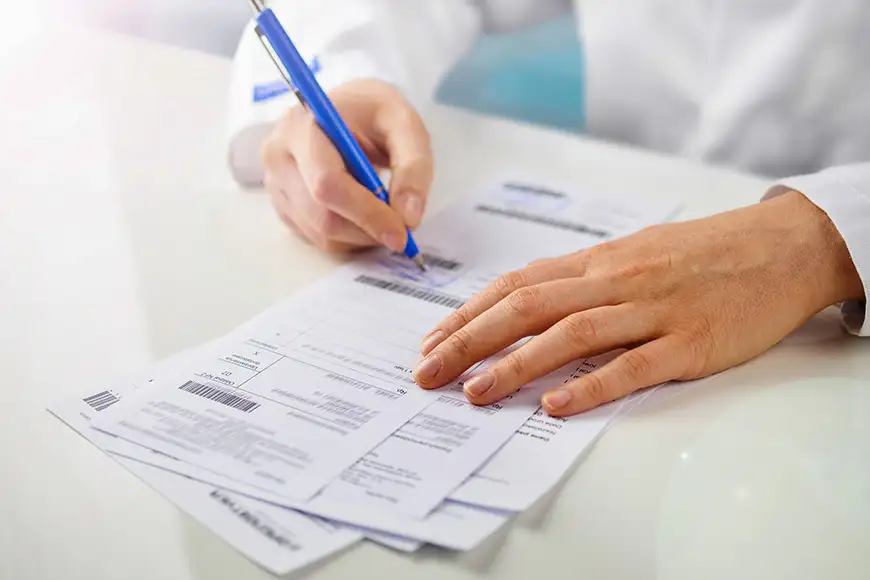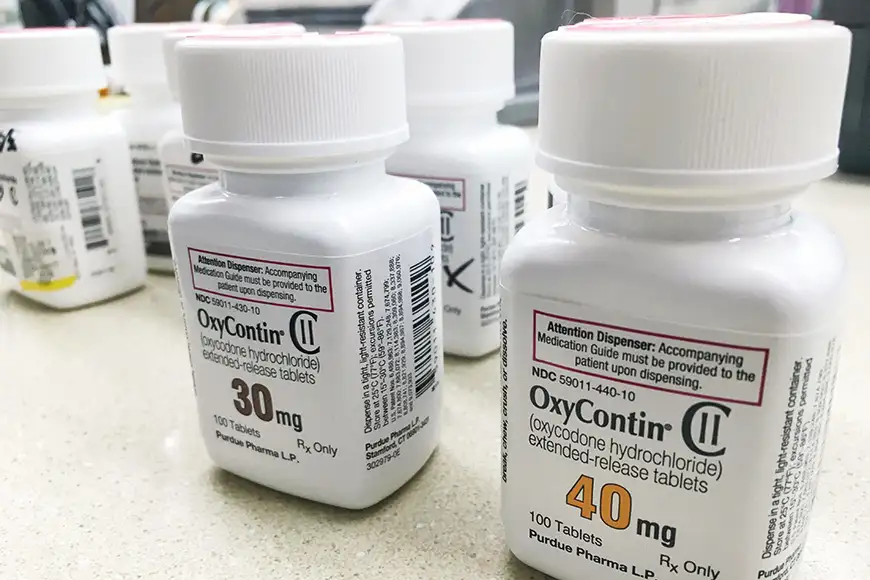
Travel Smarter! Sign up for our free newsletter.
By proceeding, you agree to our Privacy Policy and Terms of Use.
If you’re heading out on a long trip—or moving abroad—and you rely on prescriptions, it’s vital to your health to know the rules about traveling with medication. “Millions of Americans are dependent on medicines and with the globalization of travel, access to prescription medicine is even more crucial,” explains Dr. Robert Quigley, senior vice president and regional medical director at International SOS.
From how to get more than a 30-day supply of pills to what you’ll need from your stateside doctor to get a prescription abroad, here’s advice from international healthcare experts about traveling with medication.

Dr. Christopher C. Hollingsworth, MD, a general and endovascular surgeon who has practiced in Europe and the United States, says it’s unlikely you’ll get stopped at customs or border control because you’re carrying more than a month’s supply of medicine. However, having an official prescription on hand when traveling with prescription medication is never a bad idea.
“In general, countries honor the rights of travelers to transport their prescribed medications with them,” Dr. Hollingsworth explains. As long as you have supporting documentation about your medical condition (ID cards or a letter from a physician), you are unlikely to have a problem.
Dr. Brendan Anzalone, a doctor of osteopathic medicine and the president and chief medical officer at AeroMD Air Ambulance, suggests going digital with these forms, as they can get lost or creased throughout your travels. This will ensure you won’t have to go digging if you’re questioned.
Again, while it’s unlikely you will face any sort of issue when you’re flying with medication, Dr. Anzalone still recommends keeping your pills in the original bottle—complete with the sticker on the front with your name and doctor’s name—as an extra safety precaution. “Carrying your medication in [its] original prescription bottle with a label on it from the pharmacy is helpful if there are any questions in the security line,” he explains.
If you don’t have room in your luggage for the full-size bottles and must downsize, you can pack a small day-of-the-week pill organizer rather than several bulky bottles. Ensure you have documentation from your physician to avoid any potential issues. Paul Tanenbaum, R.Ph., a retired pharmacist, offers this tip if your original prescription bottle is too large: “Make friends with your pharmacist and see if he or she could make you a smaller travel-size bottle for you to fill up.”
The recommendations for domestic trips also apply to traveling abroad with medication. When flying internationally with prescription medications, the U.S. Department of State recommends storing medications in their original labeled containers and bringing a copy of a doctor’s letter to show customs officers and other officials if necessary. The prescription should note the brand and generic name of the drug.
If you’re taking an unusual drug or one that contains narcotics such as sedatives, carry a note from your doctor explaining what the medication is and why you need it.
Note that some over-the-counter drugs legal in the U.S. may be illegal elsewhere. For example, painkillers containing codeine are prohibited in the United Arab Emirates. Always double-check before you fly.

Flying with herbal medicines or supplements to international destinations can be tricky since each country has its own laws about what’s allowed in. To find out what may be restricted in the countries you’ll be visiting or transiting through, refer to the embassy website or contact local consulates.
Make sure herbal remedies and Ayurvedic medicines are in clearly labeled, well-sealed containers, preferably in original bottles. Although the TSA doesn’t require it, it may be helpful to bring a doctor’s note explaining your remedies’ intended use. Keep up to date with any changes in TSA rules by downloading its free MyTSA app (iOS | Android).
Now that you have the prescriptions you need and the note from your doc to prove your case, it’s time to pack. Depending on how much medicine you need each day, you may be tempted to shove your pill pack into your checked bag, but Dr. Anzalone warns against it: “It is best to keep medications in your carry-on baggage. If your checked baggage gets lost, you will still have your prescription medications with you. Remember some aircraft cargo holds are not temperature controlled, which may affect temperature-sensitive medications.”
If you’re worried about bringing medication that must be refrigerated (like insulin, for example) on a plane, Dr. Hollingsworth offers the TSA regulations on cool packs that are allowed through the gates. “Domestically, gel-cooling packs are allowed if frozen at time of presentation to security,” he notes.
Liquid medications (prescription or over-the-counter, like saline solution or eye drops) aren’t subject to the TSA’s three-ounce limits. However, you are required to declare anything over that amount to security officers and present it for inspection.
You may also travel with accompanying items, such as IV bags, pumps, and syringes, as long as they’re declared before you begin the screening process. All of these items will be X-rayed unless you request a manual inspection.
Travel Smarter! Sign up for our free newsletter.
By proceeding, you agree to our Privacy Policy and Terms of Use.
Dr. Hollingsworth’s rule of thumb is to bring twice the amount of medicine you need and to separate the bottles between your carry-on and your personal item. Why? Two words: flight troubles. “Changes or delays can have a butterfly effect that can have repercussions for the rest of your trip. Plan for the unexpected and pack extra medication you might need for an unplanned longer stay,” he says.

If you’re traveling with any type of prescribed narcotic used to relieve pain, such as Vicodin, Oxycontin, Percocet, or codeine, you might want to bring your prescription documentation, as well as a doctor’s note. Though this is not required by the TSA, it may prove helpful when getting through security. Since these types of drugs are widely abused, security screeners may be suspicious if they are unaccompanied by the proper paperwork. Having the original prescription will prove the pills’ necessity, and avoid any further delays or additional questioning.
The trouble of traveling with only a doctor’s note is that unless it was written in the previous month, it may lose validity. Prescriptions are clearly dated and include the signature of your doctor. Simply make a photocopy of each prescription before you have it filled. The photocopied version will be null and void, but this does not alter it as a valid document.
To take extra precaution, you may also want to travel with phone numbers for your pharmacy and prescribing doctor. This may seem like an unnecessary hassle, but it could prevent delays and problems at the airport.
If your carry-on is just too heavy to meet those puddle-jumper restrictions, Dr. Hollingsworth challenges you to be strategic. While you might want to take your mini-sized bottle of Advil, those sorts of medications are available everywhere.
“Give priority to any medications that are vital to your functioning or survival. Asthma inhalers, diabetic medications, anti-seizure medications, and blood pressure medications come to mind. Make sure to bring medications that have rebound or withdrawal symptoms if you run out,” he says. “A trip is not a good time to see how you function without your arthritis or anti-anxiety medications.”
Many factors influence whether you should purchase travel insurance. How long will you be traveling? Where are you going? Will you be lounging by a beach for a week or undertaking adventure activities in a rainforest? Do you have ongoing medical conditions that might need care?
If you’ll need health insurance for your trip, Dr. Quigley recommends exploring your options before heading overseas to determine what policy and plan are best for you. You can also work with assistance companies—like International SOS—to help you if you’re struggling with a health situation overseas.

If you’re leaving the U.S. for an extended time, in addition to getting foreign currency and shedding tears at your farewell party, you should schedule pre-departure appointments with your doctors. During these visits, get a full physical and begin a discussion about your wellness needs while traveling. Work with your physician to plan for the medications you’ll need. Medical professionals can help you secure more than a 30-day supply of any medicines along with the necessary paperwork. They can also offer advice about what you need to bring to keep your health top-notch.
Dr. Quigley explains that prescriptions cannot be filled abroad, nor can your primary care doctor call in a prescription for you. But there is a way around it: Know the generic forms and other names of the same medicine. Depending on the country, you may be able to get the medicine without a prescription.
As an example, Dr. Hollingsworth was able to walk into a pharmacy in Paris and receive antibiotics for a pal with a serious ear infection—no note required. Even so, packing a few “just in case” prescriptions before you leave will help ease your worries. Your primary care doctor or a travel clinic can help you navigate the options.
Tanenbaum recommends caution: “If you must obtain your meds from somewhere other than your U.S. pharmacy, beware that there is a major problem of counterfeit drugs out there.” He also notes that brand and generic drug names may differ from one country to another: “The same name may be for a totally different medication; if you have to get some while overseas, it may not be what you usually take so that it does not treat your medical condition, and may actually be dangerous for you to take.” Make sure you’re visiting a reputable pharmacist (ask for a recommendation from your hotel or the local tourist board) and that you double-check whether the drug you’re requesting actually treats your condition.
Plan ahead, especially if you are switching time zones and have to take medicine at a certain time of day. “Have a medical itinerary run parallel to your day-to-day travel itinerary. Plan out the nearest towns [to] where you’re going to be and identify the best providers for you based on your specific medical needs. Don’t let it be a fire drill when you get there,” recommends Dr. Hollingsworth. “If you know in 30 days [that] you need to have a prescription refilled, and you know where you will be within that time frame, then research which medical professional will be best for you. Do your homework.” It just may save your trip—or even your life.
Lindsay Tigar is a travel and lifestyle writer with a constant thirst for adventure and exploring new lands. You can find Lindsay globetrotting when the mood strikes, making sure to find time to explore both the wine and fitness scene in countries across the globe. Her work has appeared across dozens of outlets; learn more at LindsayTigar.com.
Editor’s note: This story was originally published in 2017. It has been updated to reflect the most current information. Molly Feltner, Jessica Labrencis, Patricia Magaña, and Michele Sponagle contributed to this story. A previous version of this story had an incorrect spelling of Paul Tanenbaum’s name. It has been corrected. Some of the links featured in this story are affiliate links, and SmarterTravel may collect a commission (at no cost to you) if you shop through them. As an Amazon Associate, we earn from qualifying purchases.
Travel Smarter! Sign up for our free newsletter.
By proceeding, you agree to our Privacy Policy and Terms of Use.
We hand-pick everything we recommend and select items through testing and reviews. Some products are sent to us free of charge with no incentive to offer a favorable review. We offer our unbiased opinions and do not accept compensation to review products. All items are in stock and prices are accurate at the time of publication. If you buy something through our links, we may earn a commission.




Brought to you by ShermansTravel

Regent Seven Seas Cruises


Travel Smarter! Sign up for our free newsletter.
By proceeding, you agree to our Privacy Policy and Terms of Use.
We hand-pick everything we recommend and select items through testing and reviews. Some products are sent to us free of charge with no incentive to offer a favorable review. We offer our unbiased opinions and do not accept compensation to review products. All items are in stock and prices are accurate at the time of publication. If you buy something through our links, we may earn a commission.
© 2024 Smarter Travel Media LLC. All Rights Reserved.